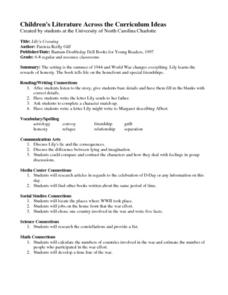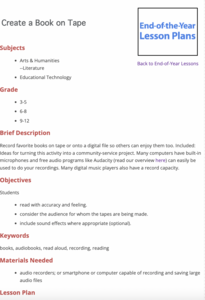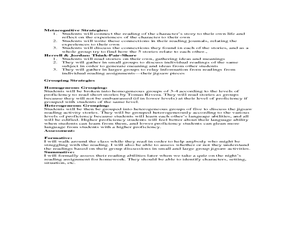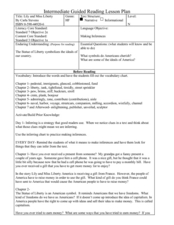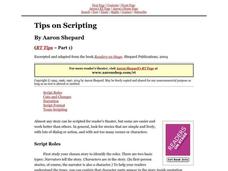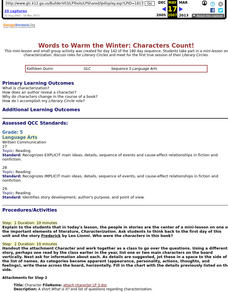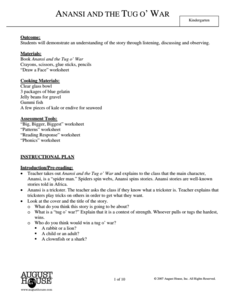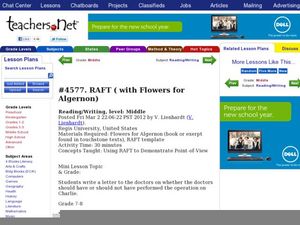Curated OER
The Lion, the Witch, and the Wardrobe: Bio Poem
Get to know your learners on a deeper level or invite them to step into someone else's shoes by introducing them to a bio poem. With this type of poetry, scholars will answer questions such as self-description, hopes for the future, and...
Curated OER
Lily's Crossing
Students listen to a story, "Lily's Crossing," about life during a World War. After completing worksheets, they compare and contrast characters in the story. Using math skills, students develop a time line of the war, calculate the...
Curated OER
Create a Book on Tape
Learners of all ages record themselves reading their favorite books with accuracy and feeling. They must read with sound effects and consider the audience for whom the tape is being made. They are assessed based on the quality of their...
Curated OER
Hispanic and English Literature
Eleventh graders listen to a brief history lesson about the 40's and 50's mid-West America and the Migrant workers that worked the fields. Next, learners will read a short story written by Tomas Rivera (both in Spanish and English)....
Curated OER
On The Day You Were Born
Students engage in a study about the holiday of a birthday with the help of using children's literature. They make cognitive connections of using the characters of the book and relating them to the personal celebration of a birthday.
Curated OER
Lily and Miss Liberty
Learners discuss ways to earn money and why they might need it. Students create crowns to wear all day like in the story. Learners create a play using characters in the story. Students interview "eyewitnesses" at the unveiling of the...
Curated OER
So Foul and Fair a Play
Students watch various interpretations of Shakespeare's Macbeth in film. In groups, they examine the setting, characters, music and sequence. They compare and contrast the various films and discuss the differences. They write an essay on...
Curated OER
Introduce Vocabulary: Clap Your Hands
Read Clap Your Hands to explore new vocabulary with your class. In this three-tiered vocabulary instructional activity, youngsters read the book and identify the plot, setting, and characters. They also define vocabulary terms from...
Curated OER
Picture Collage Book Report: Voltaire's Candide
Here's an alternative to a traditional book report for your class to demonstrate that they understand and can articulate the main character's evolution and the social themes presented in Voltaire's satirical novel Candide. Your young...
Curated OER
Running Out of Time: Problematic Situation
What would you take with you if you were traveling on your own to a different place? A different time? Pupils decide individually and then in groups what the main character of Running Out of Time should take on her trip. Coming to a...
Curated OER
Their Eyes are Watching
Fourth graders create a character map for each character in the novel, adding to each as he or she is revealed in "Their Eyes Were Watching God." They document how each character deals with attitudes and injustices.
Curated OER
Mr. Peabody's Apples
Young scholars read Mr. Peabody's Apples. In this reading instructional activity, students complete pre-and post-reading activities to improve comprehension skills. Young scholars role play scenes from the story to analyze.
Curated OER
Speak What We Feel, Not What We Ought to Say
Young scholars examine and create their own interpretation of a particular character from the play, King Lear. They read the speeches, write a paragraph about their character, and present a short performance of their scene.
Curated OER
Words to Warm the Winter: Characters Count!
Fifth graders take part in a mini-lesson on characterization, discuss roles for Literary Circles and meet for the first true session of their Literary Circles.
Curated OER
Morning Girl
Fifth graders read the novel "Morning Girl" by Michael Dorris. Using the text, they compare and contrast the two cultures, Arawak and Taino in the novel and research the landing of Columbus in San Salvador. They create a family tree...
Curated OER
The Secret life of Minor Characters
Students read Julius Caesar line by line. They discuss what is going on in a particular scene. Each student in a group takes the role of an assassin and comes up with a clear characterization and motivation. They share and watch within...
Curated OER
Colors, Characters, & Clues
Students investigate inferences. They define inference, view a Powerpoint presentation, answer questions about a picture book, and identify clues throughout the story as examples of inferences.
Curated OER
Colors, Characters, & Clues: White Socks
Students examine the process of making inferences. They define inference, view a Powerpoint presentation, and as a whole group locate clues in the pictures of a short story, locating written clues to reinforce their conclusions.
August House
Anansi and the Tug o' War
Combine art, math, language arts, drama, and delicious Jell-o with a instructional activity based on the African folktale Anansi and the Tug o' War. Kids make predictions and discuss plot points of the story before joining in...
Curated OER
Defining Character, With Help from History
In a single, soundly-designed class period, high schoolers define good character, think-pair-share about thought-provoking quotes on character (More options would enhance the discussion, worth searching online for other quotes to add.),...
Museum of Disability
Zoom!
Turn your class' focus on how wheelchairs assist individuals with disabilities to become more independent with this disabilities lesson plan. Scholars listen to a read aloud of the book, Zoom! by Robert Munsch, answer...
Curated OER
A Separate Peace: Chapter 11 Reading and Study Guide
To better comprehend the novel, A Separate Peace by John Knowles, learners define 3 vocabulary words, define 1 literary term, and respond to 10 short-answer questions. This resource refers only to Chapter 13 of the book.
Curated OER
Flowers for Algernon: RAFT
Should Charlie undergo an operation to increase his intelligence? A mini-lesson for a unit on Daniel Keyes novel Flowers for Algernon uses a RAFT activity, which prompts learners to write a letter to Charlie's doctors explaining why they...

